The Championship playoff final back in May must feel like a distant memory for Southampton fans.
At the time of writing, prior to the international break, the Saints find themselves rooted to the bottom of the Premier League.
To compound their plight, Opta has predicted only a 5.23% chance of survival for the South Coast side, with a predicted points tally of 23.
To put it in context, no team has ever survived on such a total.
This is, however, despite Southampton being one of the dominant forces in the league in terms of possession rates – only Manchester City, Tottenham, and Liverpool average more possession per match.
Such rates are certainly positive for Russell Martin’s side, and it would appear there is scope for a path to survival with plenty of the season left to contest and the Saints only four points from safety.
In this
data-driven analysis and scout report, we will highlight where Southampton must improve on the pitch and offer solutions for strengthening before the January transfer window looms.
Southampton’s Current Squad
According to Transfermarket, Southampton currently has the largest squad in the top flight.
The plot below shows the age profiles and number of 90s played for those who have featured in the Premier League this season.
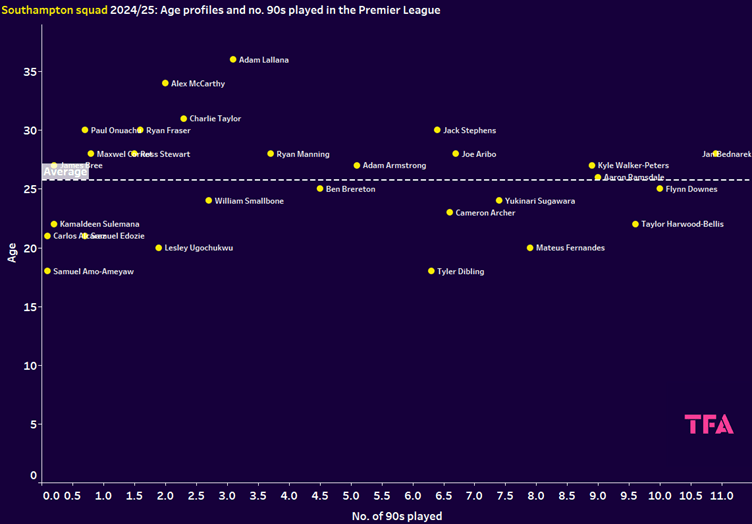
The graph shows the average age of 26 for players who have featured in this campaign so far, indicating a squad with players in their prime.
Some older squad players, including Adam Lallana and Charlie Taylor, add much-needed Premier League experience; the summer acquisition of Aaron Ramsdale from Arsenal was a shrewd business move.
While this squad, on paper, is a blend of more experienced individuals and promising young talents such as Mateus Fernandes and Taylor Harwood-Bellis, the typical starting XI comprises players who have played at the top level but notably have suffered relegation with the Saints in the past.This is particularly true of their defensive line, which includes Jan Bednarek, Jack Stephens, and Kyle Walker-Peters.
Southampton will undoubtedly want to bolster this squad in January.
Still, realistically, they will first have to look to offload some of the players currently on this already bloated squad’s books.
Southampton Defensive Frailties
Even though Southampton secured promotion last season, an achilles heel of theirs has been their defence as they languished in mid-table for goals conceded last campaign.
This aspect of their game has not improved this season, as only Wolves, Brentford, and Ipswich have conceded more in the league; only Ipswich has a worse expected goals-against rate than Southampton’s 22.4.
Martin’s playing philosophy is for his side to play out from the back, but losing possession in dangerous areas has been commonplace.
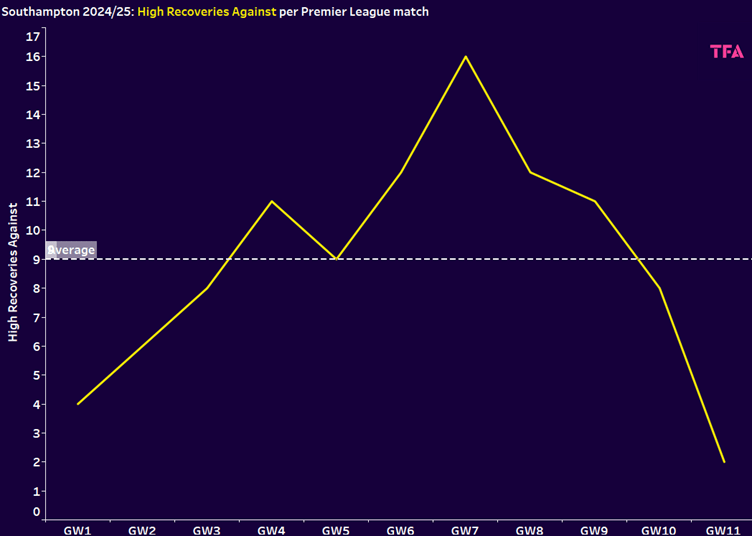
*Data courtesy of Ben Griffis’ post-match Streamlit app
A worrying theme for Southampton has been their vulnerability against high recoveries.
The Saints have averaged nine high recoveries against, as shown in the above plot, which is higher than the league average of 5.8.
Southampton may have got away with such poor possessional play at the back in the Championship, but the Premier League is more unforgiving.
They rank top of the division for the most errors leading to shots and the most errors leading to goals.
For example, Southampton succumbed to conceding goals against Brentford due to sloppy play at the back, as highlighted below, where they were dispossessed when playing the ball across their defensive line.
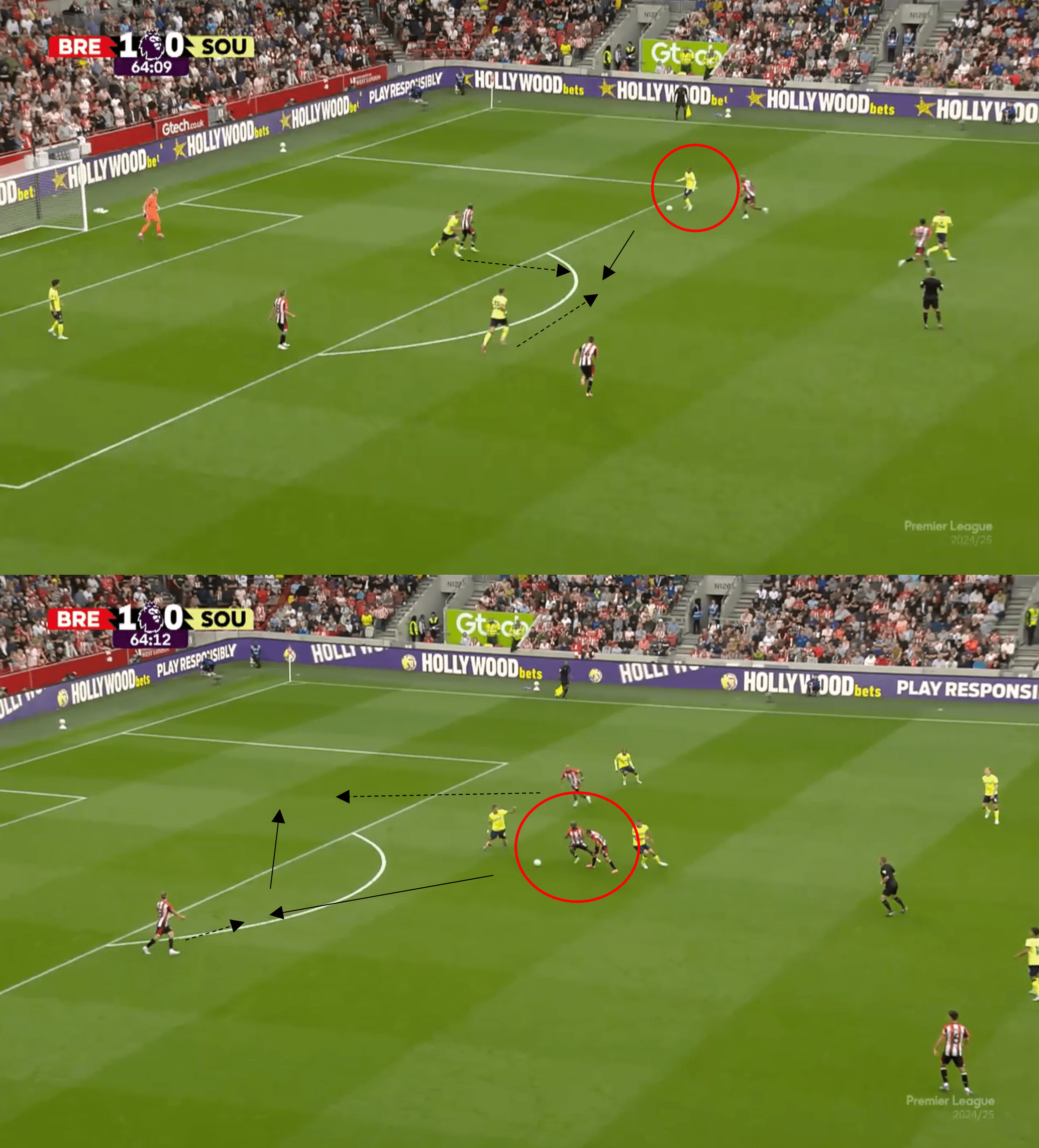
Harwood-Bellis and Bednarek have been the Saints’ preferred centre-back partnership, but as the radar charts show below, neither has been particularly strong defensively.
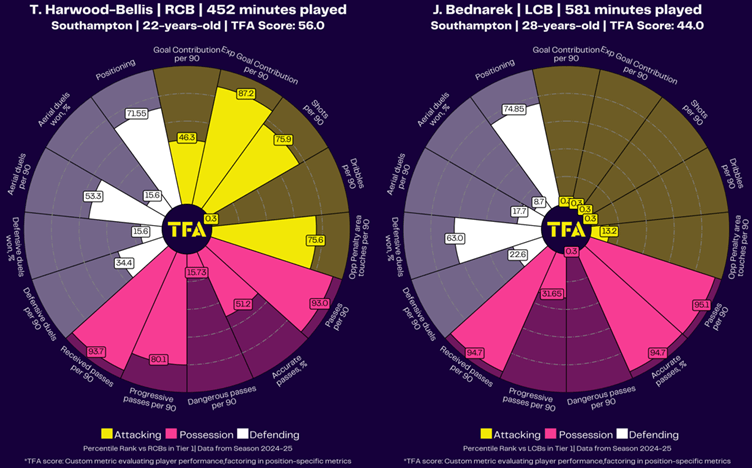
The radar charts compare the Southampton defenders to their peers in other tier-one leagues this season.
It is noticeable that both defenders rank low in the percentage of aerial duels won and in the percentage of defensive duels won for Harwood-Bellis.
In addition, the data highlights that neither defender has been productive when in possession, with low rankings for dangerous passes per 90.
Harwood-Bellis is more positive in possession, as testified by his higher rank for progressive passes; however, the data suggests his passing play lacks accuracy.
Bednarek, especially, rarely looks to carry play out from the backline.
For all Southampton’s possession rates, they are not productive with it.
In the recent fixture against Wolves, the Saints had 71% of the play, but the majority of their passes that match were made between the centre backs, Bednarek and Harwood-Bellis.
Another takeaway upon review of Southampton’s possessional play from a defensive viewpoint is the positioning of the wider options of the defensive line.
For example, Walker-Peters’ positioning, on average, is inverted and very central for a right-back.
This has been detrimental to his defensive duties, as he ranks below the median for defensive positioning compared to other tier-one wingbacks.
Southampton’s tendency to play their full-backs high and central has been commonplace this campaign under Russell Martin’s tactics.
This highlights a weakness of theirs — vulnerability in defending the flanks.
Teams have exploited this, as shown here, where Arsenal counterattacks and are able to play Gabriel Martinelli on the left-hand side as they only had the more central defenders to beat.
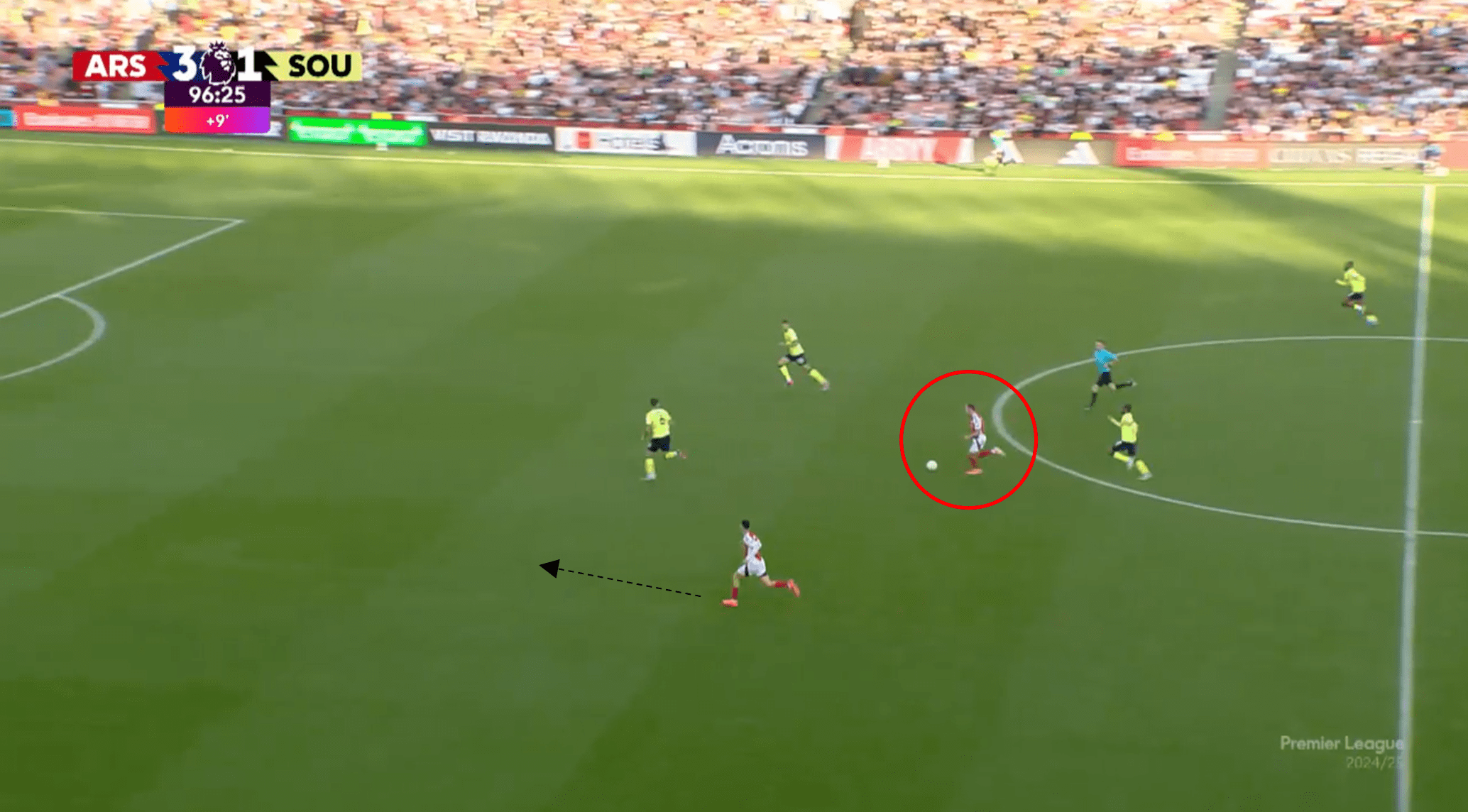
From a tactical perspective, Southampton will need to review the positioning of their playing personnel.
Although inverting the fullbacks facilitates congesting the central areas of the pitch, the Saints’ tendency to be wasteful in possession leaves them exposed to counterattacks.
Walker-Peters does rank in the 67th percentile for the percentage of defensive duels won, so with better defensive positional discipline, he could be useful to this Saints backline.
However, Southampton lacks a commanding figure at the heart of its defence, as testified by the fact that only Wolves have conceded more goals from set pieces in the league.
Given Russell Martin’s style of play, though, Southampton will need to look for someone who is comfortable in possession and solid defensively.
Southampton Lacking An Attacking Drive
From an attacking perspective, Southampton have only found the back of the net on seven occasions, the lowest in the league.
The Saints’ expected goals scored for the season to date are 11.9—only Wolves, Leicester, and Ipswich have lower values.
Mateus Fernandes has often been one of the Saints’ biggest attacking threats this season.
Recently, against City, the summer signing was the only consistent passing midfield option for Russell’s side.
However, Fernandes struggled for involvement against Wolves, which is of particular concern considering they are one of their relegation rivals.
Mateus Fernandes Progressive Passes
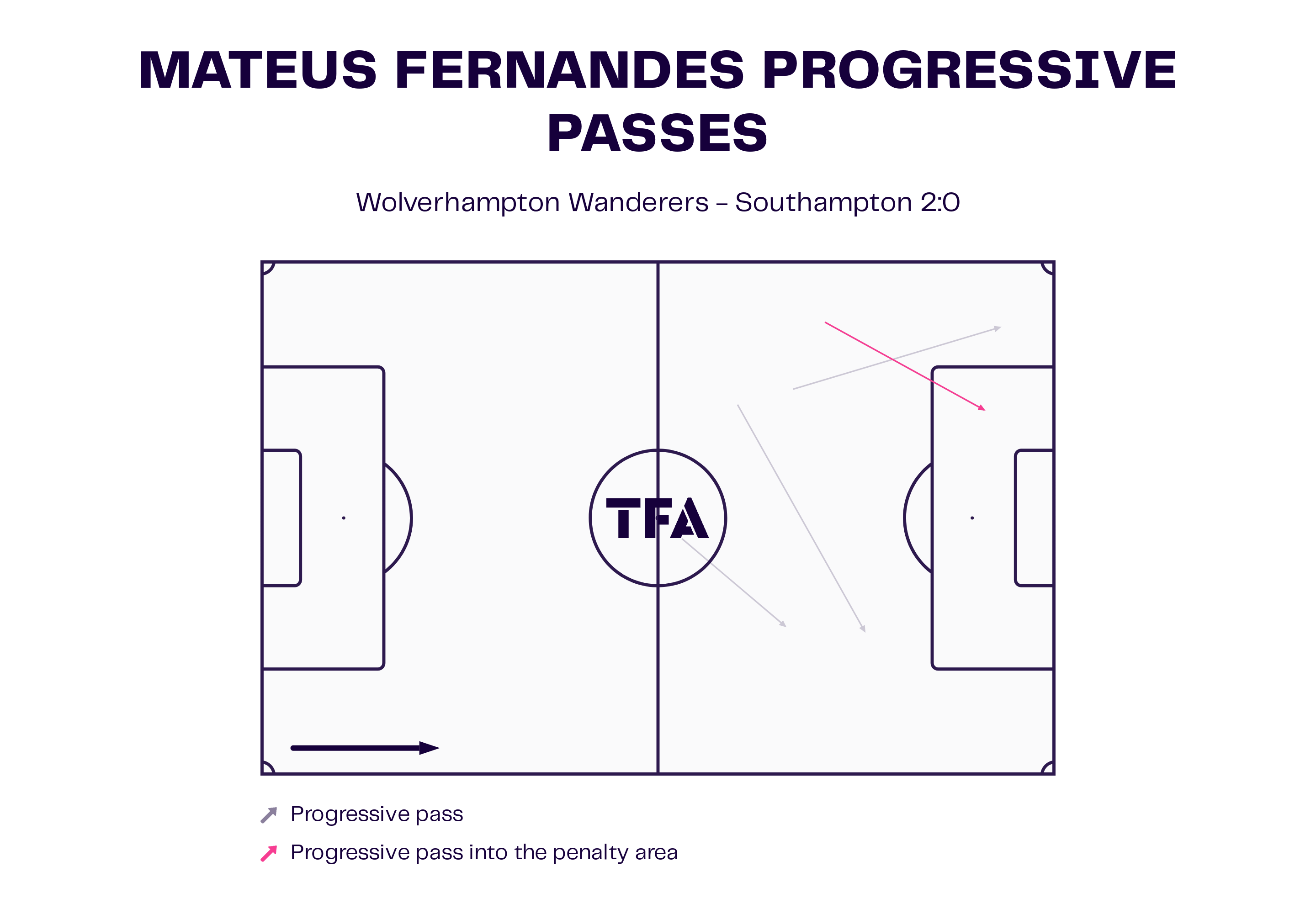
The midfielder only made four progressive passes, and only one of them was taken to the opposing penalty area.
It paints a bleak picture of the Southampton attack.
Despite dominating possession so often this season, Southampton has struggled to dominate in the final third, as shown in the heatmap below.
Southampton Heatmap
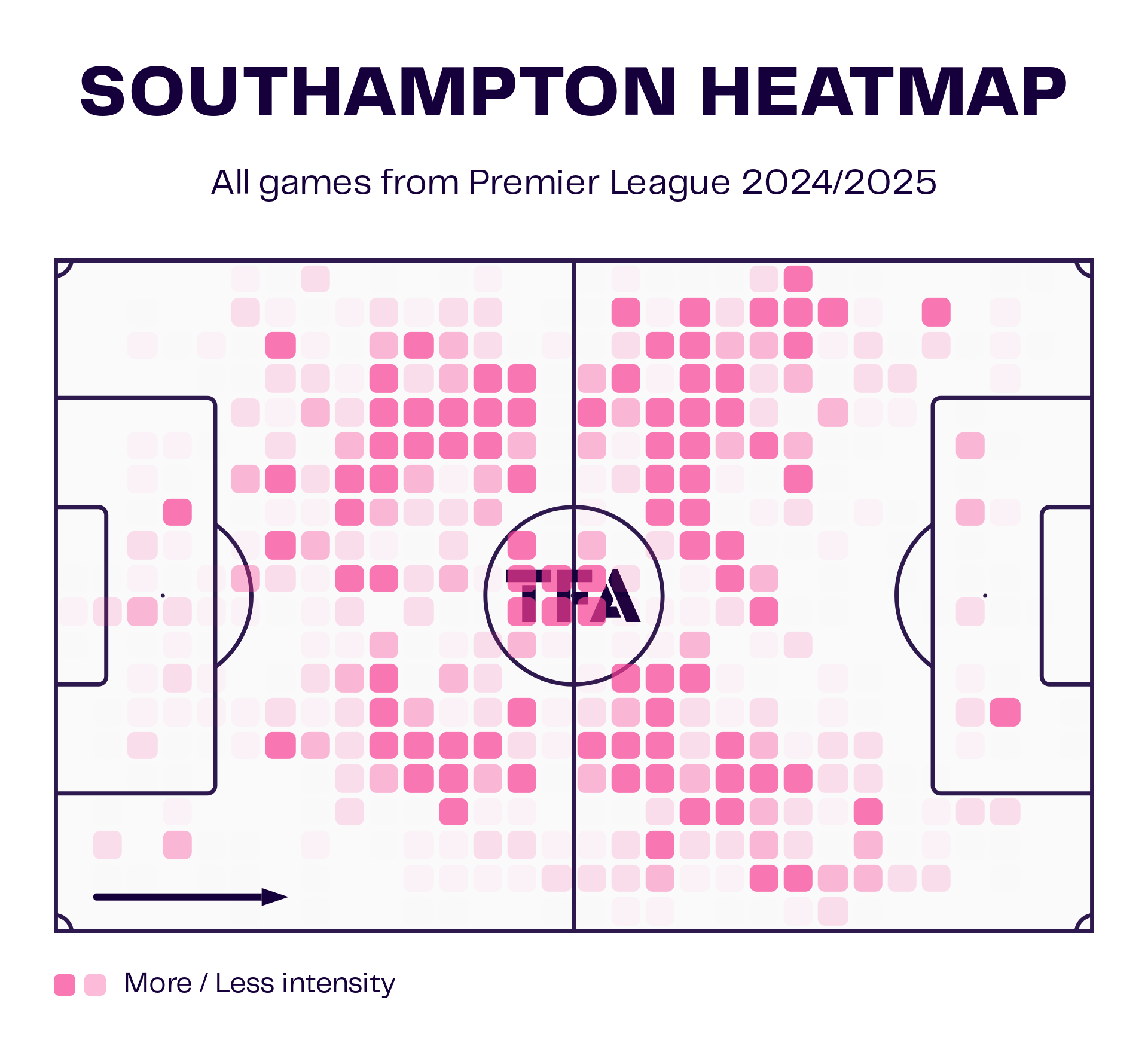
The Saints have lacked a threat on the wings, with an average of 1.09 crosses into the penalty area per 90 minutes, the lowest in the division.
Furthermore, as the heatmap alluded to, Southampton have struggled to impose themselves centrally on the edge of the box.
The Saints squad lacks a player who can take possession and drive forward.
Arguably, such a direct approach isn’t in keeping with Martin’s current patient build-up at St Marys, but if the Saints are to be more of a threat in the future, they will need to be more adventurous.
Southampton averages 10.2 shots per 90 in the league, and only Ipswich has an average of fewer.
However, the Saints do have an exciting prospect in forward Cameron Archer, who has intelligent movement in the box and the speed to play off the shoulder of the defender.
The former Villa man has not had the service from the midfield, though, and he is under more pressure when he is given a goal-scoring opportunity.
Archer has only converted 14% of his goal attempts so far, and Southampton has only converted 6% of their goal attempts collectively.
It goes without saying that the Saints will need to be much more clinical if they are to survive.
However, a positive of this side is that their average PPDA is lower than the league average, indicating an intense pressing strategy.
However, compared to Crystal Palace, which has a higher PPDA than the league average, the Saints have completed fewer high regains than the Eagles, as testified in the graphic below.
Southampton & Crystal Palace High Regains
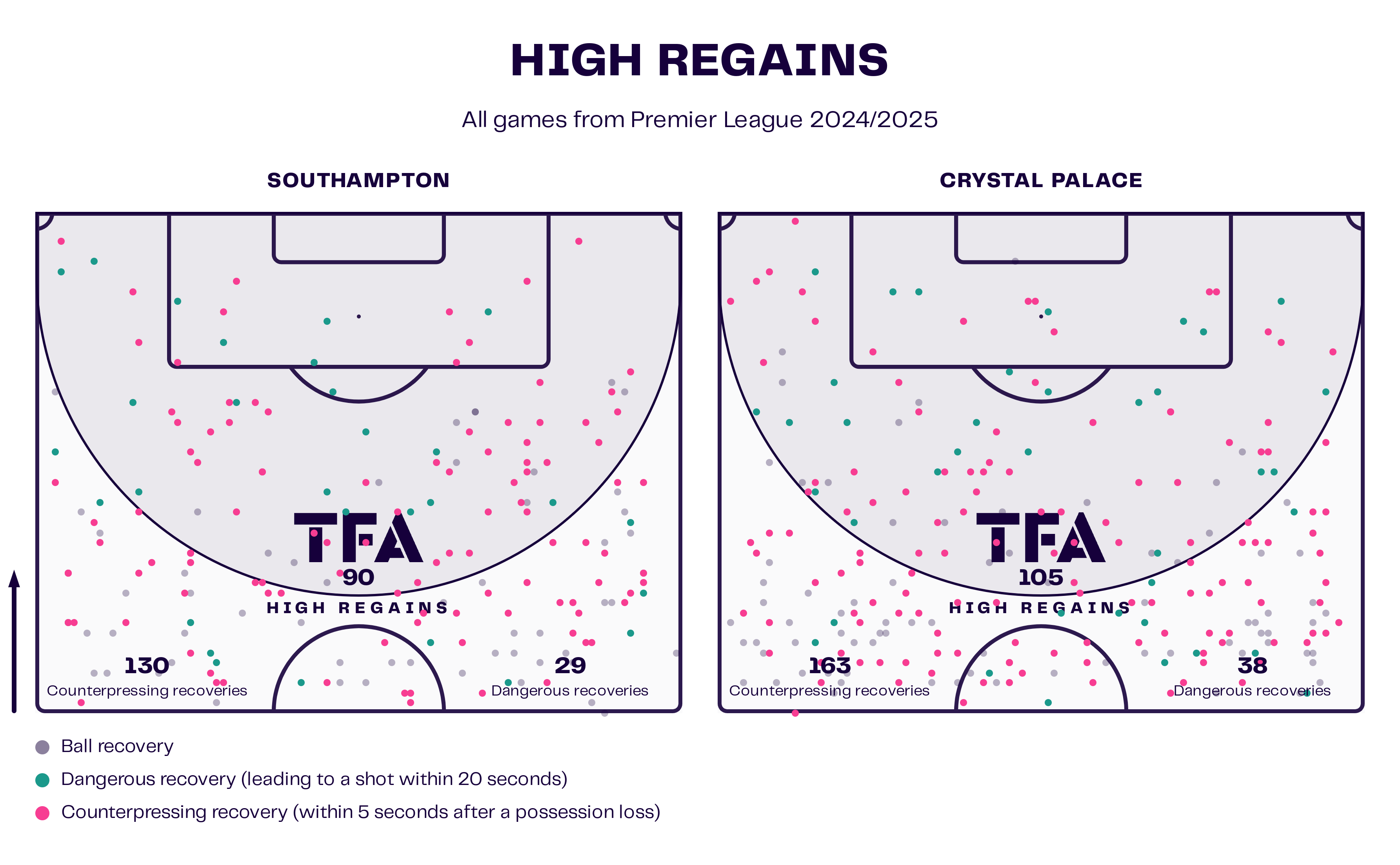
If the Saints could be more aggressive with their press higher up the pitch, they could create more goal-scoring opportunities.
Potential Southampton January Signings
As we’ve discussed in this article, Southampton’s squad lacks the personnel capable of executing Martin’s preferred playing style.
As the January window approaches, the South Coast side should ideally be looking for players with experience in English football.
One player who could improve the Saints’ defence is Brighton centre-back Adam Webster.
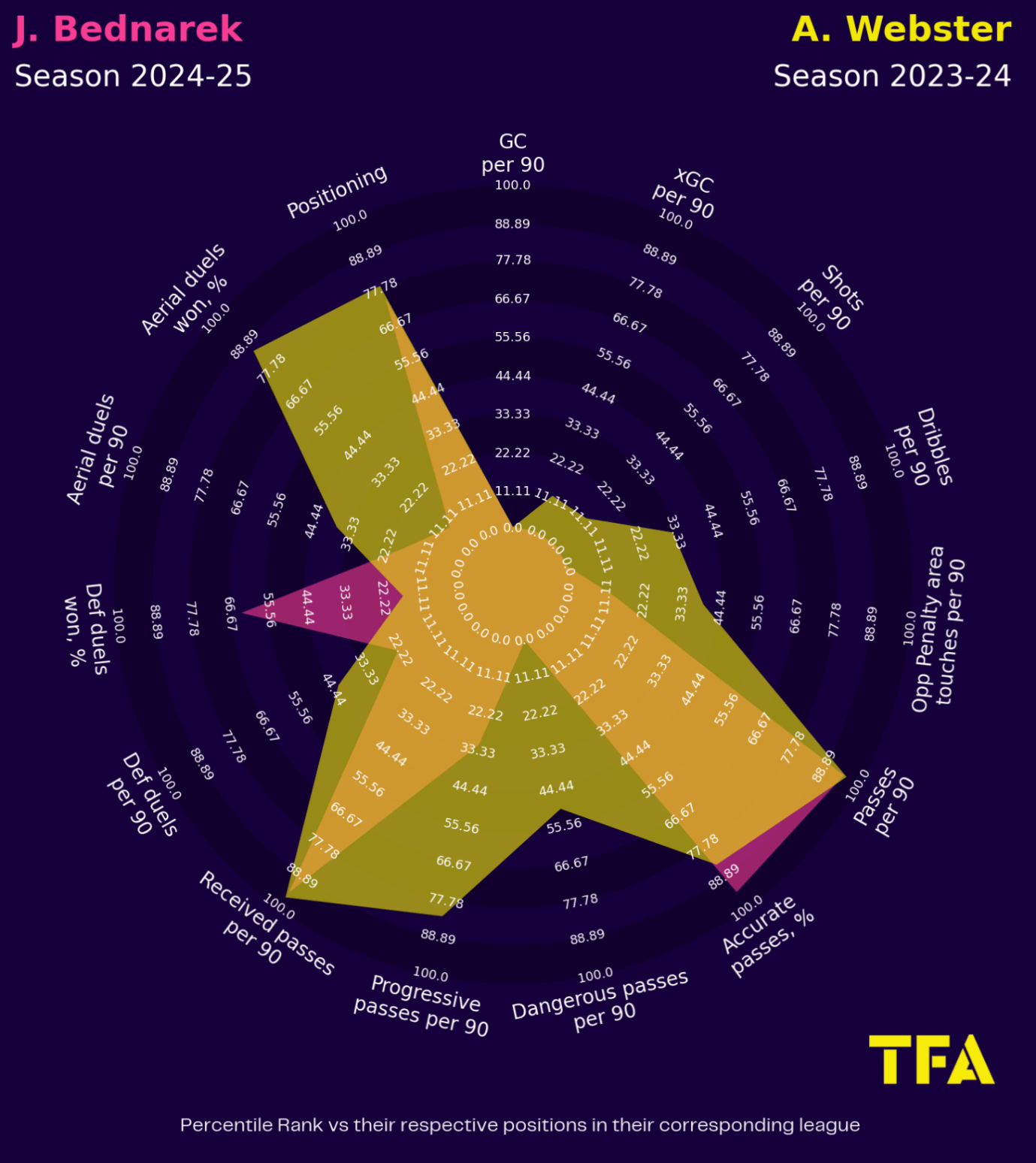
The radar plot pits Bednarek’s credentials against Webster’s displays from last season.
The current Brighton defender is notably much more comfortable in possession and has a stronger aerial presence.
Webster has fallen down the pecking order at the Amex since Fabian Hürzeler’s arrival, but he could be a credible addition to the Saints’ backline.
Over the years, the defender has been a big part of Brighton’s evolution from Premier League relegation candidates to European qualifiers.
Various managers have come and gone, implementing their own formations but with an overriding desire to play possession-based football.
Given Martin’s preference to maintain a similar possession-based approach, Webster could seamlessly slot into this Southampton squad and be the leader they so desperately need.
Regarding the attacking issues to be addressed in the next window, the Saints need a player who is comfortable at accelerating forward.
We have identified Watford’s Giorgi Chakvetadze.
The Georgian midfielders’ style of play is exactly what Southampton is missing; they need someone who, upon receiving a pass, will instinctively turn and accelerate forward, as exemplified below.
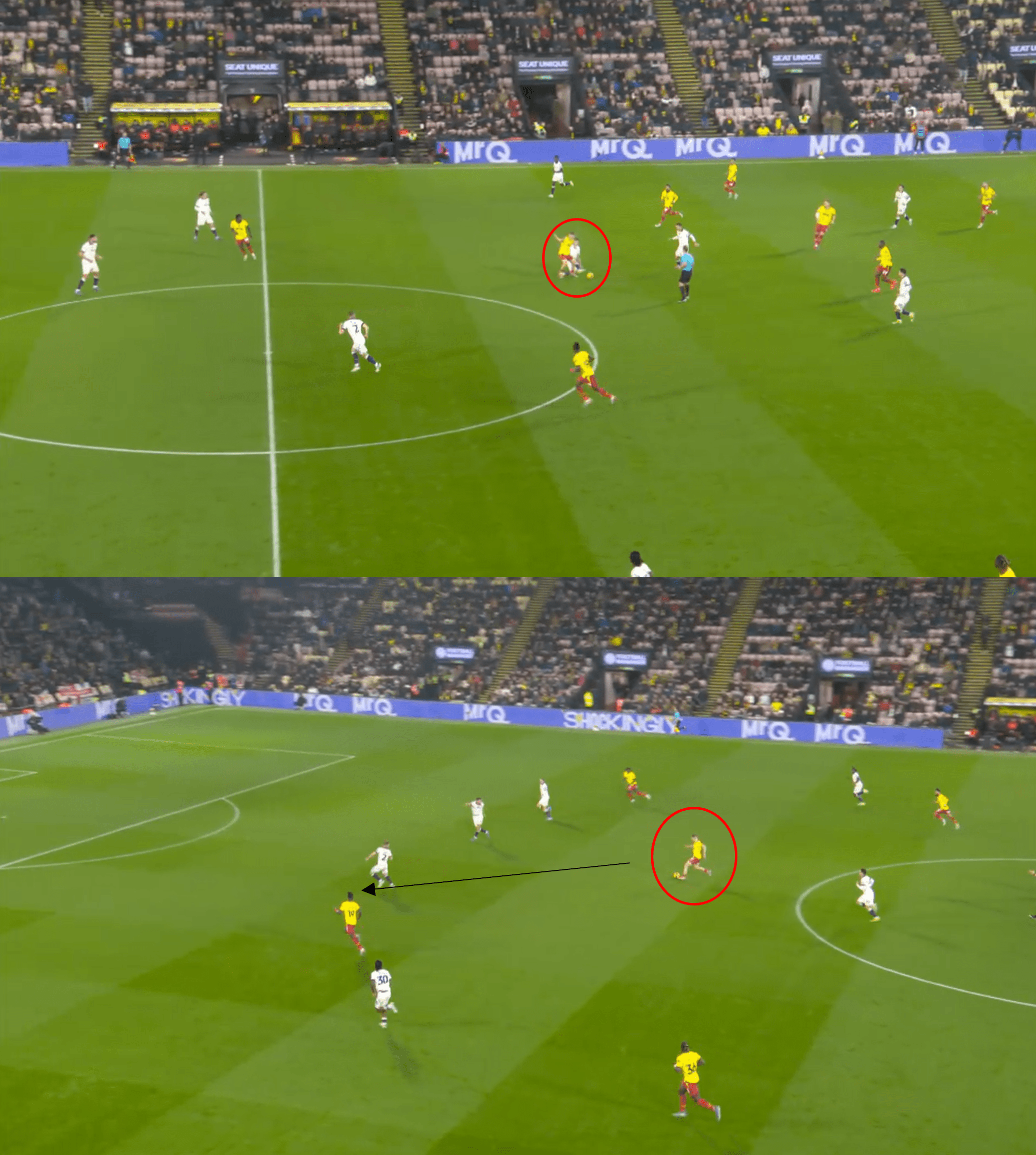
Chakvetadze could improve his goal return and potentially be an ideal player to link up with Fernandes and Archer.
The Watford man tops the Championship charts for progressive carries into the final third this season, as well as a number of through balls – the type of service that Archer needs when holding the Saints’ attacking line.
Chakvetadze’s tendency to occupy the central and left side of the attacking third would open up interchanging positional play with Fernandes, giving Russell’s side more variety in the future.
The Georgian international’s attacking instinct could also benefit the Saints in attacking transitions against stronger sides such as Arsenal and Man City when they have tended to play a deeper defensive line.
Our final signing suggestion is a striker who could add a much-needed clinical touch – Callum Wilson.
Wilson ranked third in the league for non-penalty expected goals per 90 and ranked in the top 10 for goal conversion rate for players to have featured for at least five 90 minutes last season in the top flight.
This shows that he gets into good goal-scoring positions and is adept at finishing.
Wilson has struggled for game time at Newcastle this season and will undoubtedly be eager for more minutes, so Southampton has room to negotiate a deal for the forward.
However, to create a more balanced squad, the Saints must look to sell in the upcoming window.
Numerous players who have yet to feature or have featured very little this season are on the books.
Conclusion
By delving into the data, we have highlighted some flaws at Southampton, both tactically and in terms of the available playing personnel.
With the January transfer window around the corner, we have made some suggestions that could improve the spine of the St Marys team.
Whether there is transfer activity on the horizon, St Mary’s current playing style needs to be more direct.
It is admirable to impose such a possession-based system at the top level for a newly promoted side, but it comes with a sense of naivety.
Martin must learn the art of adapting if Southampton are to survive.

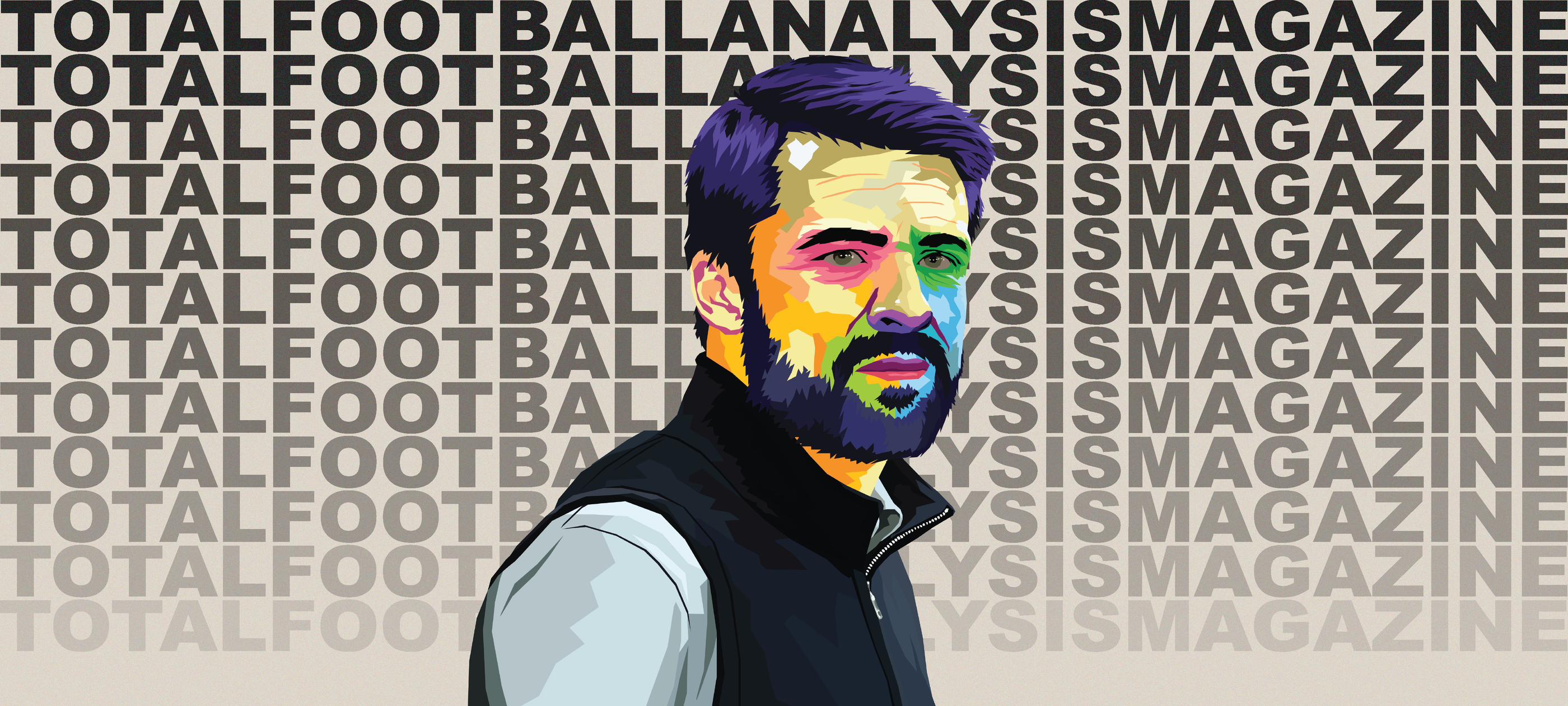




Comments